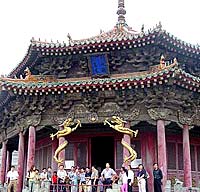 This capital city of Northeast China's Liaoning Province should revitalize its tourism industry by tapping into its Qing Dynasty (1644-1911) heritage, according to local experts and insiders.
This capital city of Northeast China's Liaoning Province should revitalize its tourism industry by tapping into its Qing Dynasty (1644-1911) heritage, according to local experts and insiders.
"We should fully utilize the city's Qing heritage to attract more tourists," said Chen Tiexin, director of the local tourism administration.
Shenyang, known as an old industry base in Northeast China, is the birthplace of the Qing Dynasty culture.
It was the economic and political centre of North China before the Qing ruler Shunzhi moved his capital to Beijing in 1664, and then was named as the "accompanying capital."
One palace - the Shenyang Imperial Palace - and two tombs -- known as the Beiling and Dongling tombs - are the highlights of the Qing Dynasty historical relics.
The Shenyang Imperial Palace, the residence of Nurhachi (1559-1626) and Huangtaiji (1592-1643), is the only integrated royal architectural complex in China apart from the Forbidden City in Beijing.
The Shenyang municipal government is sparing no efforts to get the palace and the tombs onto the World Heritage List.
Maintenance and renovation work to restore the relics' appearance is going smoothly.
"Various performances which reflect the common life of the ethnic minority people during that period can attract more visitors," said Zhi Yunting, director of the Shenyang Imperial Palace Museum. He said offering snacks made according to ancient recipes could help visitors better experience the Qing culture and customs.
"Many historical events, royal protocols and activities of the Qing Dynasty, including the wedding ceremony of gege, the emperor's daughter, could be displayed to visitors," suggested Li Zhongyuan, vice-chairman of Shenyang Historical Relics Research Association.
Holding seminars and exhibitions on Qing culture and history could foster the development of the tourism industry as well, he added.
Li also encourages the government to publish more books, documents and picture albums in both Chinese and English to help visitors better understand the Qing culture.
(China Daily January 2, 2003)
|

